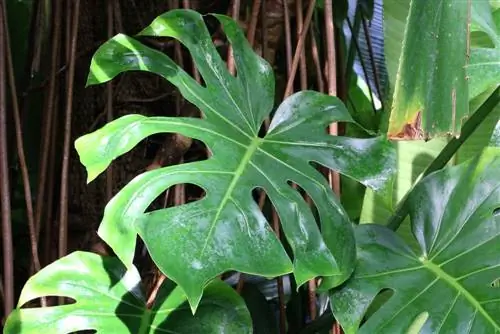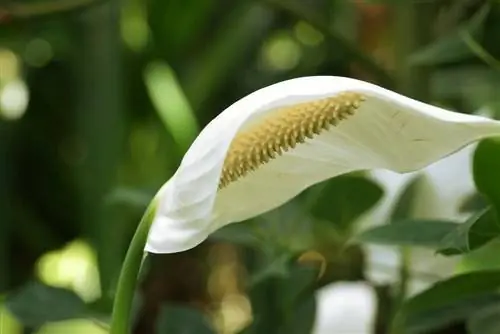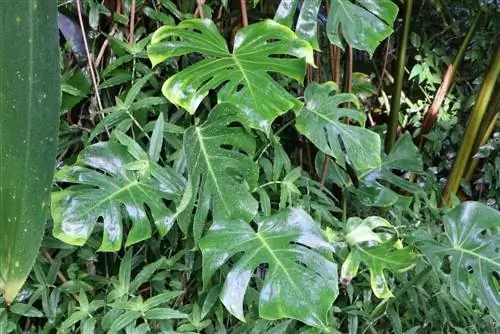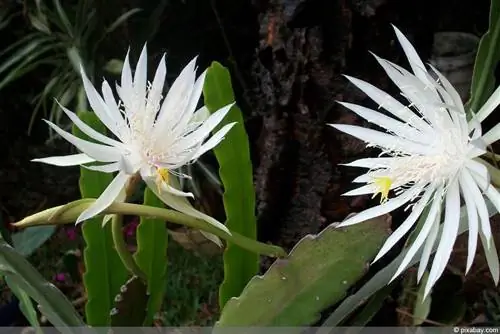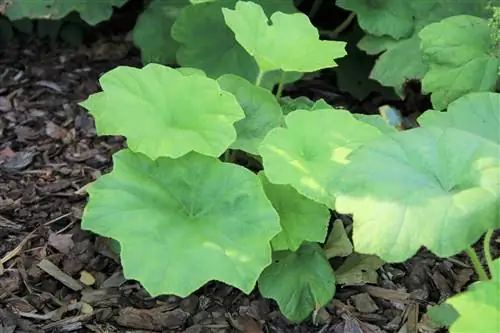- Author admin [email protected].
- Public 2023-12-17 03:39.
- Last modified 2025-06-01 06:48.
The Monstera is also called window leaf, thanks to its openwork leaves, which are vaguely reminiscent of windows. The plant originally comes from the tropical regions of South America. Due to its low demands, it is well suited for people who have little experience with houseplants or who don't have much time to take care of a plant.
variety selection
The wild form Monstera deliciosa is mainly sold in stores. It is the original form of this species, but there are also other cultivated forms that differ in growth and leaf colors. The following varieties are available:
- Borsigiana: compact growing
- Albovariegata: variegated
- Variegata: creamy white leaf patterns
In terms of care, all varieties should be treated equally.
Location
The window leaf grows on trees in the tropics. It is protected from the sun under the canopy of leaves. Similar conditions should also be offered indoors. It is particularly important that it does not receive direct sun, as this can damage its leaves and its development. This makes it suitable for greening rooms where there is little or no daylight, such as vestibules or bathrooms. The ideal location should look like this:
- bright location
- no direct sun
- Temperature: ~ 20°C
- high humidity
Tip:
If the window leaf is on a cold tiled floor, at least a coaster should be used. Alternatively, a wooden board can be used as an insulating layer.
The right location is particularly important for young plants. They are very sensitive to direct sunlight. Older plants are somewhat more robust and can tolerate direct sun for a limited time. However, they should not have a permanent place in the sun either. In summer, the plants can be placed outdoors without any problem. A shady balcony or the north side of a house is ideal.
Substrate
The window leaf has strong growth and can reach considerable dimensions. Development is favored by the right substrate. This is made up of:
- 1/3 leaf soil
- 2/3 compost soil
- some perlite or cocohumus
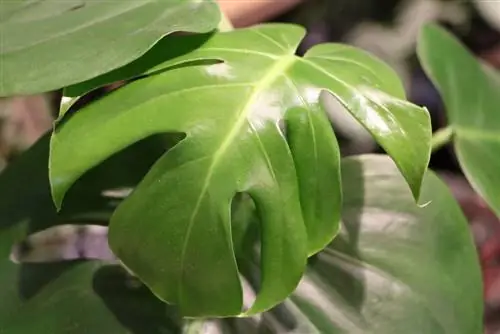
Perlite or cocohumer are used to keep the substrate loose and permeable to air. Perlite also has the ability to store water to a limited extent. The window leaf is also suitable for hydroponics. The following materials can be used as a substrate:
- expanded clay
- Quartz gravel
- Vermiculite
If gravel is used, make sure that it is actually quartz gravel. For example, if the gravel contains lime, this can harm the plant as it does not like calcareous soil.
Planting
The window leaf has strong growth, which is why a significantly larger container should be chosen when planting. A drainage is placed in the vessel as the bottom layer. This can consist of pottery shards from broken pots or gravel or expanded clay is used. Then some substrate is filled in and the plant is inserted. The pot is filled with the remaining substrate up to the watering edge. However, it is important that the aerial roots are not accidentally planted.
Note:
With hydroponics, there is no drainage layer. However, material of varying coarseness can be used, with coarse-grained substrate forming the lower layers and increasingly finer substrate being filled towards the top.
Pouring
The window leaf requires high humidity. Therefore, not only should the substrate be moist, but the leaves should also be moistened at regular intervals. To do this, they can be wiped with a sponge or sprayed. Many people simply put the plant in the shower and rinse it at lukewarm water. On a rainy day, the window leaf can also be placed on the balcony. However, as soon as the blazing sun shines on the balcony again or it gets too cool, the plant has to be brought back inside.
Tip:
Indoors, the humidity can be increased with a humidifier. Alternatively, you can place a container of water on the radiator in winter.
To increase the humidity in the immediate vicinity of the window leaf, the plant can be placed in a saucer on a slightly raised base. Clay granules are placed in the coaster and then the bowl is filled to the brim with water. This is significantly less time-consuming than spraying the plant regularly or wiping the leaves.
When watering, the following should be taken into account:
- only water when the surface is dry
- use low-lime water
- Avoid waterlogging
Although the window leaf is native to the humid tropics, it does not tolerate waterlogging. This can lead to the plant rotting.
Fertilization
From spring to autumn, the window leaf is supplied with liquid fertilizer every two weeks. A commercially available fertilizer for green plants is sufficient for this. In addition, fertilizer sticks for green plants can be used as long-term fertilizer. The plant also needs a rest period in the winter months. The fertilizer doses are also reduced. From around October to February, liquid fertilizer is fertilized a maximum of every four weeks.
Trail support
In nature, the window leaf climbs up branches and trunks. To do this, it uses its numerous aerial roots. When growing in a pot, the Monstera definitely needs a climbing aid or support. Otherwise, older plants in particular with very large and heavy leaves can break off.
The following materials are suitable as climbing aids:
- Bamboo sticks
- Moss sticks
- Bamboo trellis
- Trellis with coconut filling
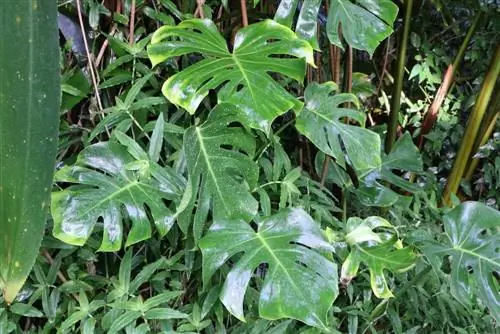
Basically, sticks and grids with a rough surface should be used as climbing aids, as this is the only way the aerial roots can find a good grip. A normal branch can also be used as a climbing aid. Smooth surfaces, such as bamboo sticks, should be wrapped with natural materials such as moss.
Care for aerial roots
The aerial roots are an essential part of the plant and are vital to it. They not only serve as an adhesive organ, but also provide the plant with nutrients and water, which is absorbed in the form of air moisture. The aerial roots are very sensitive and can break easily. The aerial roots can become very dominant and sometimes unsightly. However, you must not cut the aerial roots of the plant, as this can cause lasting damage. Instead, unwanted aerial roots are carefully inserted into the soil.
Tip:
For a limited time, the aerial roots can be placed directly in the water. This means the plant can survive a longer period without being watered, such as when you are away for a long time on vacation.
Cutting
Apart from the aerial roots, the window leaf is very easy to cut. You can easily cut the window leaf to shape, which is sometimes necessary due to its size, which can be up to three meters. You can cut the plant back with a sharp knife. The cut on a leaf is made about 10 cm above the point of growth on the trunk and should be straight.
If it is necessary to cut the plant radically, this is also not a problem. You can even cut back the main shoot without danger. When cutting back very strong parts of the plant, they should be treated with a wound closure agent to be on the safe side. Particularly in damp rooms such as bathrooms, the formation of pathogens is encouraged due to the higher humidity.
Tip:
Instead of a commercial wound closure agent, charcoal ash can also be sprinkled on open wounds.
Propagate
Pruning often produces material that can be used to easily propagate the Monstera. Side shoots in particular are ideal for using for propagation. A shoot should consist of two leaves and several aerial roots. If a shoot has not yet formed roots, it can also be placed in a container with water. If the water is changed regularly, the first roots will form within a few weeks.
The rooted offshoots are potted up. It should be noted that there should be at least two to three aerial roots above the ground. Then it is poured and a transparent plastic bag is placed over it. Where does it prevent too much moisture from being lost? However, the bag must be lifted every two to three days to air it out. Otherwise, mold or rot may develop. In addition to propagation via cuttings, young plants can be grown from seeds. In very good conditions, the window leaf forms a stem flower with many small seeds. When propagating by sowing, please note the following:
- Fill the seed tray with potting soil
- Moisten the soil
- Sowing depth approx. 1 cm
- Cover the seed tray with a transparent cover
- Germination temperature: 20° - 23°C
- Germination time: 2 - 6 weeks

During the germination period, the soil must be kept constantly moist. Once the young plants have reached a height of 10 cm, they can be separated and planted in pots.
Repotting
If the window leaf is still very young, it should be repotted every year. This promotes he althy and strong growth. Even if you repot every year, you should always choose a container that is significantly larger than the previous one. The window leaf has a very strong growth and can become too big for the pot within a year. For older plants, it is sufficient to move them to a larger pot every three to five years. Every year, however, the top 3 cm of soil should be removed and replaced with a fresh substrate.
Diseases and pests
Not only does the plant require little maintenance, it is also robust against pests and diseases. Only scale insects and spider mites can become a problem for her. An infestation usually occurs when pests are brought into the house via new plants. If the plant remains exclusively indoors, this can promote an infestation. In summer, the Monstera can definitely be placed on a shady balcony or terrace. This also makes care easier. If a pest infestation still occurs, the following remedies have proven to be effective:
- Shower plants repeatedly or place them in the rain
- Scrape off scale insects
- Promote lacewing larvae or hatchlings as natural enemies
- Use systemic insect repellents if there is a heavy infestation
The window leaf should be checked regularly for pests. It is also a warning sign if growth stagnates or stunted leaves appear. In addition, an infected plant must be isolated from other houseplants.

